
Adult Bee Conditions
Honey Bee Viruses
Of more than 20 known viruses affecting adult honey bees, some can be grouped based on clinical symptoms, although many others have no obvious visible characteristics. Many viruses are common, and exist at low levels in a colony without becoming pathogenic. These generally weaken individual bees, shorten their lives, and result in smaller, less productive colonies without inducing overt signs of disease. However, other environmental stresses, such as poor nutrition or mite parasitism, can exacerbate colony health.
Some honey bee viruses replicate in specific organs or tissues, and may be transmitted in numerous ways. Some are passed to larvae in brood food, or between adult bees through trophallaxis (food sharing). Other viruses are vectored by parasitic mites, which physically weaken bees and impair immune response while transmitting the pathogens, and thus severely impact colony health. The most accurate diagnostic tests for viruses rely on DNA testing, are performed only by specialized labs, and can be expensive. To reduce the prevalence of viral infection and transmission in a colony, keep mite levels low.
Deformed Wing Virus
One of the most recognizable viral infections is caused by deformed wing virus (DWV). It can be apparent as bees emerge from pupation with wrinkled, malformed wings, and may exhibit other deformities such as rounded, shortened abdomens. Severely infected bees may be expelled from the colony and may be observed crawling in front of the hive entrance. This condition is most noticeable in summer, when bee and mite populations are both high.
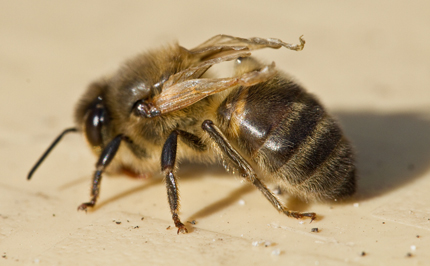
A worker bee with deformed wing virus, which usually suggests a severe varroa mite infestation. Photo by Klaas de Gelder (flickr.com/photos/klaasdegelder).
DWV-infected bees cannot fly and cannot perform useful duties in the hive. It is common for infected bees to display no overt symptoms, but will have reduced life spans and impaired learning ability, and can still carry and spread the virus. DWV is transmitted between bees primarily by varroa mites, and is known to replicate within mites, between feeding on different bees. Because they were fed as larvae, but are unable to later contribute to the colony, an abundance of infected bees can greatly impair productivity and overwintering success of a colony. Continual management of varroa is essential in preventing outbreaks by reducing opportunities for mites to transmit DWV to the next generation of developing brood.
Paralysis Viruses
A complex of viruses with similar effects can be grouped as the paralysis viruses. These include slow paralysis virus (SPV), acute bee paralysis virus (ABPV), Israeli acute paralysis virus (IAPV) and chronic bee paralysis virus (CBPV). Different viruses affect different tissues or parts of the bees. Symptoms will vary but may include adult bees that are unable to fly and may tremble as they walk. They may shiver their wings, may have bloated abdomens, or may have disjointed wings. They may or may not have a dark, greasy, hairless appearance. They generally exhibit progressive paralysis until death, and usually do not live long. They may be harassed or expelled from the hive by other bees, and may be observed crawling near the entrance.
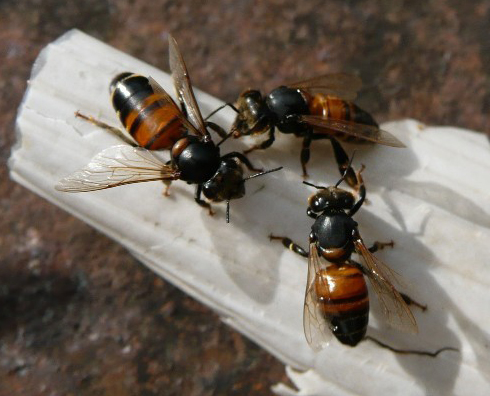
Bees infected with paralysis viruses may have a dark, greasy, hairless appearance. Photo courtesy The Animal and Plant Health Agency (APHA), Crown Copyright (UK).
Some of these viruses can infect bumble bees and other insects. All are thought to be common in honey bee populations at low levels, but can become highly virulent in association with varroa mites. Vigilant mite control remains the best defense against these viruses.
Nosema
Nosema disease is caused by a microscopic fungus called a microsporidium, of which two species are known to affect honey bees. Nosema apis was the common European strain, with recognizable symptoms Typically seen during and at the end of winter, it was simple to treat. However, it has now largely been displaced by an Asian strain, Nosema ceranae, which is more virulent, can appear in summer and fall, and can be more difficult to detect or control.
Nosema is common at latent levels, and may not adversely affect an otherwise healthy bee colony. However, when a colony becomes stressed (by mites, poor nutrition, or other pathogens) then the microbes can evade a bee’s immune system, leading to a severe infection that impairs foraging behavior, reduces brood care, significantly shortens life span, and decreases winter survival.
These microbes are parasites of the midgut portion of the honey bee digestive tract. Bees consume spores, either when sharing food with infected bees or when cleaning the hive. In the bee’s midgut, spores replicate as they destroy the epithelial cells that line the stomach. Reproduction takes 3-4 days, with resulting spores able to immediately infect more cells. As spores multiply, the midgut begins to swell, and bees become progressively weaker. Bees are increasingly unable to digest food, so wastes accumulate in the hindgut and spores are passed with feces. When bees are confined for extended periods, as in overwintering hives or during shipment, the spores can be spread readily though the bee population via fecal contamination of bee hive surfaces.
Streaking with fecal material on frames and near hive entrances is one obvious sign of nosema, but similar dysentery symptoms can also be caused by poor diet. Infected colonies may not always display overt symptoms during good weather, when bees are free to take cleansing flights away from the hive. A number of other symptoms are associated with nosema, but are not necessarily indicators of this disease. These include slow spring build-up, dwindling adult population despite abundant forage, bees crawling on the ground unable to fly, and bees displaying K-wing.
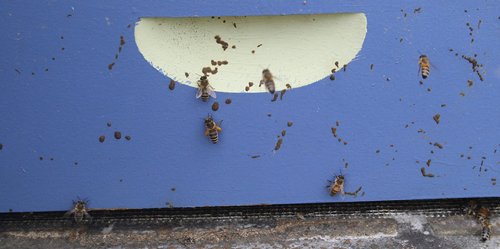
Visible streaking with fecal matter on the front of the hive can be a symptom of nosema infection, but it can also simply be dysentery caused by a poor diet. Photos by Michael E. Wilson (beeinformed.org)

Removing a midgut for diagnosis. Photo courtesy Randy Oliver (scientificbeekeeping.com)
When young adult bees become severely infected with Nosema, they may not digest food at all, and become incapable of producing brood food. These bees may skip nursing duties and prematurely begin foraging, which significantly shortens their lives and puts additional pressure on other bees to tend the brood. Queens that become infected are usually superseded. Severe infections result in weak colonies and high winter mortality even when overt symptoms are not obvious.
Nosema infection cannot be positively diagnosed without a microscopic examination of the bees’ midguts. A sample of 25 bees is recommended, viewed using 400x magnification. Older bees, crawling on the ground in front of the hive, are the most likely to have higher spore counts. However, the threshold for N. cerana spores has not yet been clearly established, and the simple presence of spores does necessarily indicate a severe outbreak.
Traditionally nosemosis was treated with an antibiotic called fumagillin, but research suggests that resistant strains have developed, and the medication may be insufficient to cure an infection of N. ceranae. The best way to prevent this condition is to ensure that bees have a continuous diet of good food, with access to the outside for cleansing flights. During periods of dearth, adding essential oil mixtures to syrup can stimulate feeding, which helps to flush the digestive tracts, and rid bees of excess spores. Spring and summer bees have short life spans, so spores may not have sufficient time to germinate to dangerous levels. Nosema disease is most prevalent in overwintering populations, and therefore is a more significant problem for beekeepers in climates with long colder winters. Feeding probiotoics may help, by allowing beneficial microbes to competitively exclude harmful microbes in the bees’ digestive tract, but sufficient research in this area is currently lacking. Woodenware and combs that have been exposed to nosema can be sterilized by scrubbing or fumigating with 80% acetic acid or by freezing equipment for at least 4 days.
K-Wing
Honey bees have two pairs of wings, the forewings and hindwings. Bees can hook these pairs together during flight, then unhook and fold them back while at rest. Sometimes their wings become disjointed, and the hindwings will stick out somewhat perpendicular to the body in a position that can resemble the letter K. Unable to fly, these bees may be seen walking around on the ground in front of the hive. This does not indicate a specific disease, but can be a symptom associated with several conditions including nosema infection, severe tracheal mites, or even some viruses. A microscopic diagnosis of the bees is necessary to determine the exact cause, but the presence of numerous bees exhibiting this symptom is cause to investigate further.
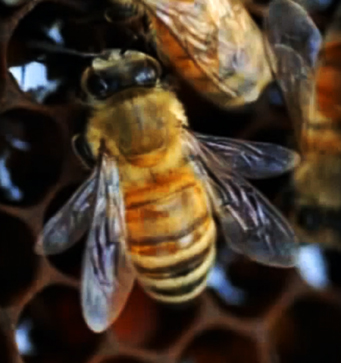
K-wing is not a disease, but can be a symptom of several unrelated problems. Photo courtesy James D. Ellis, University of Florida.
Starvation
A common cause of winter mortality is starvation, or rather, the bees freeze to death because they have run out of honey stores to convert into heat energy. Dead bees are found in the spring with their heads in cells, as if searching for food. Usually a small cluster of dead bees is found on the comb, often with the queen, while many others are found in the bottom of the hive.
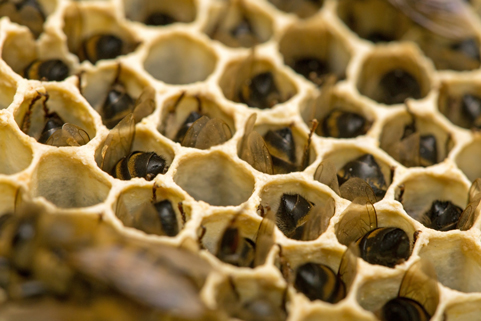
Honey bees that have starved are usually found with their heads in the bottoms of cells, as if they had been searching for food. Photo courtesy Alex Wild (alexanderwild.com)
Occasionally a colony is found to have starved just a few inches from combs full of honey. This is usually after a period of extremely cold weather, causing the bees to tightly cluster and consume all the food within reach. Individual workers are unable to move away from the warm cluster for food, and the cluster itself is unable to break up and move around the edges of the empty comb and onto frames with honey. This can only be avoided if there is ample food above the cluster, onto which they can easily move. Colonies that are found to have little food in cold weather should be provided with syrup or candy boards. If a wintering colony is discovered dead with food in it, place all frames of honey into another hive, and store all combs safely. If left unattended when the weather warms, a dead-out may be robbed by other bees, or the hive may become infested with small hive beetles and wax moths.

Click the 'X' to exit fullscreen.